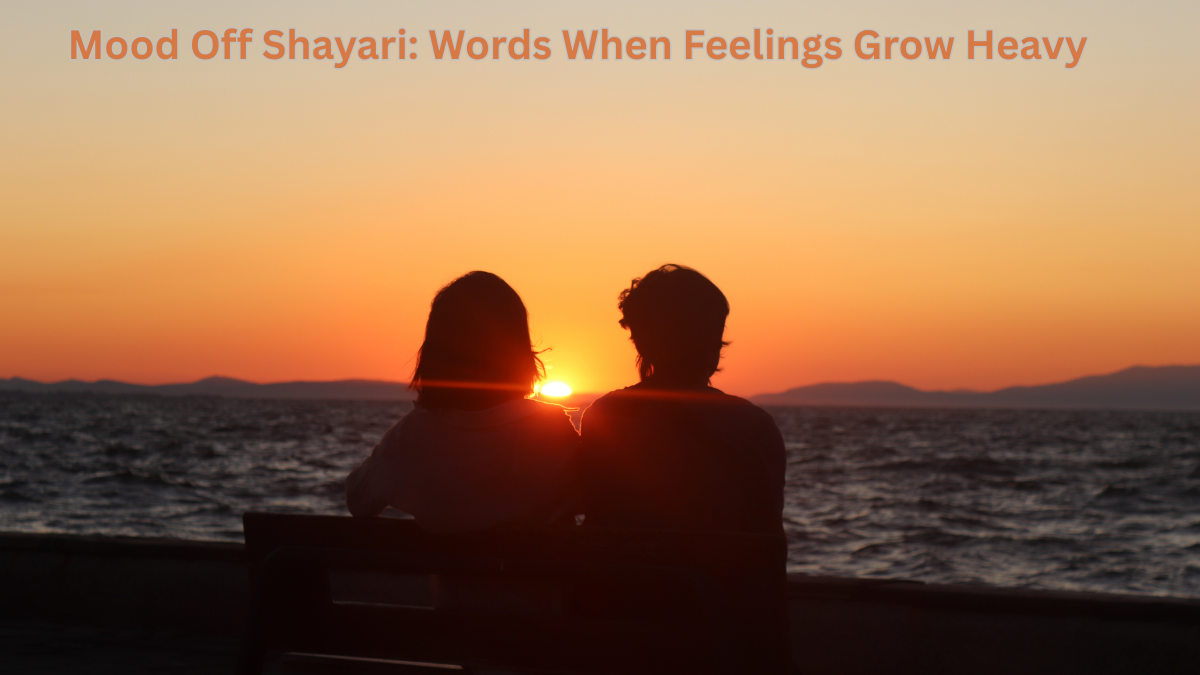When someone looks for mood off shayari, they are not only searching for poetry but also for comfort. They may be feeling low, navigating heartbreak, carrying unspoken sadness, or simply needing words that mirror the weight inside them. Shayari—short, lyrical, emotionally charged verses—has long been a companion during such times. Within the first few lines, it tells us: you are not alone in your feelings.
This article explores what mood off shayari really means, how it shapes our emotional landscape, and why it continues to provide solace in an age where our feelings often remain hidden behind screens.
What Is Mood Off Shayari?
Shayari is a form of poetic expression, deeply rooted in Urdu, Hindi, and South Asian literary traditions. It often condenses profound emotions into just a few words. Mood off shayari specifically refers to those verses crafted during moments of sadness, loneliness, or disappointment.
It isn’t just about rhymes or rhythm—it’s about resonance. When people encounter such verses, they often think: This is exactly what I’m feeling but could never say.
Why People Turn to Shayari in Sad Moments
Life, in its constant rush, rarely pauses to acknowledge sadness. Shayari steps in as a gentle voice. It gives shape to emotions we can’t easily articulate.
Reasons people seek mood off shayari include:
- Emotional reflection: It mirrors what one is going through.
- Catharsis: Reading or writing verses becomes a release.
- Connection: It bridges loneliness by reminding us others have felt the same.
- Expression: For those who struggle to speak, shayari becomes their language.
- Aesthetic comfort: Even sadness, when placed in poetic form, feels softer, more bearable.
The Language of Sadness in Poetry
Shayari often thrives on imagery. Rain is not only rain; it is tears. A night without stars becomes a metaphor for emptiness.
Common motifs include:
- Rain: cleansing, sorrow, or longing.
- Broken mirrors: shattered self-image or broken trust.
- Empty streets: loneliness and wandering thoughts.
- Fading light: the decline of hope.
These motifs become symbols, easily understood across cultures.
Historical Roots of Sad Shayari
Sadness in poetry is not a modern invention. Ancient Persian poets, classical Urdu masters like Mirza Ghalib, and Hindi poets of the Bhakti movement often wrote about longing and melancholy.
Shayari emerged as a medium to balance beauty with grief. Even when the heart broke, the words were crafted delicately. This balance between sorrow and artistry is why mood off shayari continues to live on social media feeds, in handwritten notes, and in whispered recitations.
How Modern Readers Consume Mood Off Shayari
Unlike earlier times, today’s shayari doesn’t only live in poetry books or gatherings. It travels in new ways:
- Social media captions: Instagram stories, reels, and Facebook posts.
- WhatsApp statuses: quick verses that reflect the current state of mind.
- YouTube videos: often paired with slow music and visuals.
- Memes: shayari infused with humor yet carrying deep meaning.
This digital circulation keeps the tradition alive while adapting to new audiences.
The Emotional Power of Short Lines
Unlike long poems, shayari thrives on brevity. A single line can pierce through layers of silence.
For instance:
“Dil ke jazbaat ko lafzon mein bayaan karna mushkil hai, phir bhi shayari inhein rooh se chhoo leti hai.”
The beauty lies not in how much is said but in what is felt beyond the words.
Table: Themes of Mood Off Shayari
| Theme | Symbolism Used | Emotional Impact | Example Thought |
|---|---|---|---|
| Heartbreak | Broken glass, fading letters | Pain, regret, nostalgia | “I still write your name.” |
| Loneliness | Empty roads, silent nights | Isolation, longing for company | “Echoes are my only friends.” |
| Betrayal | Shattered trust, cold shadows | Anger, disappointment | “Trust dies before love does.” |
| Yearning | Rain, distance, unreachable stars | Hope mixed with sorrow | “I wait for unseen footsteps.” |
| Healing & Resilience | Sunrise, new blooms, open skies | Growth, acceptance, quiet strength | “Tomorrow still calls my name.” |
The Dual Nature of Sad Shayari
One might assume that mood off shayari only deepens sadness. But paradoxically, it often uplifts. By externalizing pain, it lessens its weight.
A verse can hurt and heal at once. When words are beautiful, even sorrow feels meaningful. That duality is why people return to it repeatedly.
Quotes About Words and Healing
Here are a few timeless reflections that fit perfectly with the essence of mood off shayari:
- “Tears are words that need to be written.” — Paulo Coelho
- “Poetry heals the wounds inflicted by reason.” — Novalis
- “Sadness flies away on the wings of time.” — Jean de La Fontaine
- “Words can make the unbearable, bearable.” — Anonymous
Writing Your Own Mood Off Shayari
You don’t need to be a poet to write shayari. Often, it begins with a single thought written simply.
Tips to create your own:
- Start with a personal feeling you want to capture.
- Use imagery (rain, silence, moonlight).
- Keep it short—two to four lines often suffice.
- End with a twist of thought, something that leaves a lingering effect.
Example:
“Raat poochti hai tujhe,
Par mere honthon par khamoshi ka pehra hai.”
Why It Resonates With Youth
Younger generations, especially teenagers and people in their early twenties, often embrace mood off shayari. This is partly due to the intensity of first loves, breakups, and identity struggles.
In a world where emotions are often filtered through emojis, shayari provides depth. It makes vulnerable feelings feel valid.
The Difference Between Mood Off Shayari and Motivational Shayari
While both are poetic, their purposes differ:
- Mood off shayari: Embraces sadness, validates emotions, sits with grief.
- Motivational shayari: Pushes forward, encourages resilience, sparks action.
Both are essential. One acknowledges the storm; the other invites sunshine afterward.
The Timeless Appeal of Sad Verses
Across centuries, humans have carried the same emotional struggles—heartbreak, loneliness, betrayal. What changes is the language and setting, not the feeling.
Shayari becomes timeless because it speaks to something universal. Whether in ancient manuscripts or modern phone screens, it echoes the same truth: our inner world is fragile and beautiful.
A Personal Reflection: Why I Read Mood Off Shayari
Reading shayari during difficult times is like finding a friend who doesn’t ask questions but understands. It doesn’t fix the problem, but it whispers: you are not alone in this.
That reminder is sometimes all we need to keep going.
Practical Uses of Mood Off Shayari
Beyond personal reading, mood off shayari can serve in daily life:
- As journal entries when words fail you.
- As dedications in letters or notes.
- As therapy prompts, helping you explore feelings.
- As conversation starters, opening space for emotional dialogue.
Mood Off Shayari in Popular Culture
Bollywood, music albums, and web series frequently borrow lines from shayari. Sad songs especially thrive on this tradition. A film scene with a breakup often resonates more deeply when layered with poetic expression.
This cultural circulation ensures mood off shayari never disappears; it reinvents itself for each generation.
The Future of Mood Off Shayar
In an age dominated by quick content, the challenge is to keep depth alive. Yet the persistence of short-form poetry on digital platforms suggests shayari is not going anywhere.
In fact, it may become even more essential, offering depth amid fleeting noise.
Conclusion: The Comfort of Shared Sadness
Mood off shayari is not about glorifying sadness—it is about honoring it. It reminds us that being human means feeling deeply. And when words are shaped into poetry, even sadness becomes art.
Every line of shayari whispers that we are seen, that our emotions have meaning. In that recognition, healing begins.











